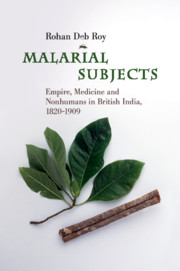Illustrations
1.1Photograph of a bottle of quinine bearing the label Howards and Sons, c. 1860–1910
1.2Title page of John Eliot Howard's The Quinology of the East Indian Plantations, first published in 1869
1.3Oil painting of Pelletier and Caventou discovering quinine by Ernest Board, c. 1910–1920
1.4Wood-engraving describing the gathering and drying of cinchona bark in a Peruvian forest, c. 1867
1.5Photograph of a cinchona nursery at Munsong in British Sikkim
1.7A sample of Cinchona Pahudiana from Java cultivated in Nilgiris, 1877
1.8A sample of Cinchona Officinalis from Madras cultivated in Java
1.9Wood-engraving of the planting of the first cinchona tree in a new plantation in the Nilgiris
1.10Wood-engraving showing Balmadie's Cinchona Plantation Near Dolcamund, Madras Presidency, 1872
1.11Photograph of local inhabitants labouring in a cinchona plantation in British Ceylon, c. 1880–1896
1.12Photograph of local inhabitants labouring at Munsong cinchona plantations in British Sikkim
2.1Image of Albarello drug jar used for cinchona bark, Spain, c. 1731–1770
2.2Sketch with the note ‘Gleaners of the Pontine Marshes. These people suffered from malaria when working on the Marshes’, 1837
2.3Lithograph of ‘A group of people adrift in a boat, perhaps suffering from malaria’, 1850
2.4Reproduction of an engraving after M. Sand (1823–1889), ‘The Ghost of the Swamp: An Allegory of Malaria’, c. 1850s
2.5Photograph of local inhabitants engaged in the cinchona plantations in Ceylon (most probably in Peradeniya), c. 1880–1890
2.6Photograph of a group of Nepalese fishermen, containing the note ‘The fishermen are Tharos, natives of the Terai, who have the peculiarity of being proof to its malaria (which in certain seasons is deadly to anyone else)’, 1876
4.1Photograph of a cinchona tree (succirubra) at the Government Plantation at Rungbee. It contains the note ‘View of three European men sitting beneath cinchona trees’, c. 1870s
4.2Photograph of ‘Cinchona succirubra and portion of Plantation No. 5 at Rungbee near Darjeeling showing the tallest plant of C. succirubra age 2 years and 9 months. The head gardener in the picture is 5 feet 9 inches in height’, 1867
4.3Sketch of the cinchona plantations in Darjeeling, Bengal, 1872
4.4Photograph of a ridge covered with Cinchona Ledgeriana in Munsong, British Sikkim
5.1Signboard on malaria issued by the imperial postal department containing the caption ‘Quinine is the only cure for malaria’, c. 1900
5.2Advertisement of Strong iron bedstead fitted with mosquito frame, January 1900
5.3Advertisement for The Folding Hood of Mosquito Net by White and Wright, 1902
5.4Advertisement for The Mosquito House by White and Wright, 1902
5.5Advertisement for Calvert's ‘Anti-Mosquito Soap’ showing one woman covered in mosquitoes while another is free from them, c. 1890
5.6Copy of the original artwork used to create the Mosquito patch during the Korean War, c. 1950–1955
5.7A cluster of four photographs showing sanitary measures being undertaken against mosquitoes, 1910
5.8Cover page of a Bengali book by Ksitishchandra Bhattacharya entitled Moshar Juddho (War of Mosquitoes), 1922
5.9Illustration used in a Bengali book entitled Hindustani Upakatha edited by Ramananda Chatterjee. The illustration carries the note, ‘The father of the farmer engages in war with the father of the bania within the stomach of a mosquito’, 1912
5.10Photograph of British troops taking their daily dose of quinine, Salonika, July 1916
5.11Photograph of Captain Robertson Sadiya and Hospital Assistant ‘throwing quinine into the mouths of loaded coolies,’ 1911–1912
5.12Advertisement of ‘Wellcome Tabloid Quinine Bisulphate’, 1910
5.13Ephemera containing the note ‘Orange Quinine Wine, prepared according to the British Pharmacopoeia, 1898’
5.14Photograph of Buffalo sacrifice during a malarial epidemic in Mettaguda in British India, 1917
5.15Photograph of ‘Sadiya. Captain Robertson and Hospital Assistant giving quinine to Nagas’, 1911–1912
5.16Photograph of ‘Quinine distribution work, (Jhelum). Villagers being given doses of quinine’, c. 1929
6.1Colour lithograph containing the note, ‘The malaria mosquito under a spotlight’, c. 1943–53
6.2Advertisement of an anti-malarial drug ‘Baikol’ published in the Bengali magazine Ananda Bazar Patrika Saradiya, 1942



